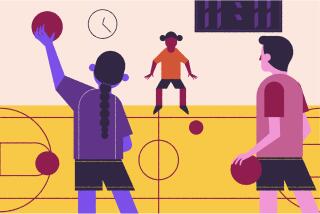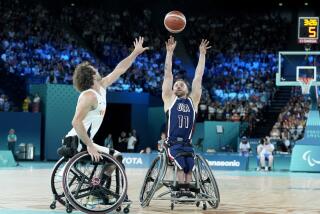It’s all up in the air
ON a chilly Monday night, kids and adults hurry up the stairs to a 1920s gym in South Pasadena where the waxed floor is littered with an assortment of juggling balls, rings, pins and even unicycles. There’s a bit of organized commotion as folks find equipment, grab a buddy and start the evening’s fun.
Standing in a circle with four youngsters is Bryan Langholz, a biostatistician at USC who comes here religiously to spread the gospel of gravity. “Let’s go!” he says, and two boys begin to gracefully juggle three balls between each other. Then, another pair joins the circle and the balls move faster in a complex Spirograph-type configuration.
Finally, Langholz pitches his balls into the loop and calls out words of encouragement. “Keep going, keep it up, we’ve got it now,” he says.
The balls spin and whiz by in precise formation and the quiet rhythm mesmerizes the group. Then, someone drops a ball. “Ahh!” the boys cry out, seeing the death of their juggling creation. “Let’s do it again!”
Every week across the Southland, jugglers and would-be jugglers meet in similar gymnasiums, college campus grounds, malls and parks to find out how to manipulate the law of gravity into not only a science but an art.
Overall, the United States has about 75 official juggling clubs, according to Alan Howard, editor of Juggle magazine, who adds there are probably more informal groups out there that aren’t affiliated with the International Jugglers’ Assn.
Writing via e-mail from a cruise ship where he’s doing a gig as -- what else? -- a juggler, Howard says, “there are lots of new jugglers [keeping] the craft going. Some focus on artistic aspects, some focus on athletic achievement and others will just do it as play.”
He notes the increased media interest in juggling: ESPN now broadcasts competitions; comic Chris Bliss is all over the Internet juggling to Beatles music; and Russian teen juggling wonders Vova and Olga Galchenko have made recent appearances on U.S. talk shows and been profiled in Time magazine.
But for most people, Howard says, juggling is a welcomed social hobby that, like doing magic, has a certain cool factor. “But unlike magicians, jugglers have no hidden secrets,” he says. “If someone can’t do it, the ones who can are usually willing to show how everything is possible, with enough practice.”
Indeed, Shlomo Nitzani says he’s taught about 3,000 students how to juggle in his 11 years as a physical education teacher at South Pasadena Middle School. He incorporates juggling in the rotation of sports offerings for his seventh-graders.
In fact, many of those current students show up with Nitzani at the Monday night festivities at the South Pasadena gym where they can refine their techniques with other advanced adult jugglers such as Langholz.
Juggling, Nitzani says, “perfects eye-and-hand coordination but also helps kids develop social skills they need at this age.” He talks about one student who came to him with failing grades as well as poor work and social habits.
Once introduced to juggling, “he took to it like crazy,” Nitzani says. “He eats, sleeps and breathes to juggle now. His grades went up because he now feels good about himself. He doesn’t think of himself as a failure anymore. And he’s a really good juggler.”
Older students also find that juggling is a welcome respite from textbooks, classes and homework.
“Juggling is controlled chaos with contained energy,” Cal State Long Beach student Jake Read says.
He’s working out with a Diablo, an hourglass-like wheel, on a grassy courtyard at the Long Beach campus with other members of the Beach Balls juggling club.
Read places the Diablo on a string and, using two handles, winds it up and then magically tosses it back and forth. He then flings the plastic object high in the air and then elegantly catches it in the middle of the string.
“I look at this as fun, but it’s also a personal challenge to get better,” Read says. “I remember my dad juggling oranges when I was a kid and it always intrigued me.”
William Murray heads up the 3-year-old juggling club at Cal State Long Beach that grew out of his passion for the pastime. “Juggling got me the job here,” Murray says as he spins five pins in front of him in an oval orbit.
Part of the requirements for landing a teaching job involved giving an academic lecture -- Murray presented a discussion on the mathematics of juggling.
STUDYING juggling patterns is a relatively recent endeavor, says Murray, who credits three groups of mathematicians -- from Caltech, UC Santa Cruz and Cambridge -- who in the 1990s came up with equations for describing objects in the air and the seemingly infinite paths they can take from point A to point B.
These shorthand notations are widely used by jugglers today and are especially useful when jugglers share information on the Internet, Murray says.
Even with its geeky components, juggling for Murray is still more art than science. “It’s like dancing,” he says. “It’s physical and good exercise plus there’s lots of room for personal expression.”
Murray scans the group of students who are on the lawn helping newcomers with the classic three-ball juggle, individually practicing a ball cascade or passing pins with each other.
Many are math, computer-programming or engineering students, but theater and music majors are also represented.
It’s a bright sunny day and Murray begins another round of pin twirling.
“People have described juggling as live Nintendo,” he says. “But being outside here sure beats any video or computer game around, hands down.”
*
Where to toss ‘em
Southern California juggling clubs meet regularly for practice, teaching and socialization. All clubs welcome youngsters to learn the craft; and moms and dads are encouraged to stay and make the meetings a family affair and not just a “drop-off” activity.
The Beach Balls: Noon to 2 p.m. Mondays through Thursdays, 6:30 to 8:30 p.m. Tuesdays and Thursdays. Cal State University Long Beach, 1250 Bellflower Blvd., Long Beach. (562) 985-5339; www.csulb.edu/org/beach
balls/v1/index.php.
Cal State Fullerton Juggling Club: Meeting times vary, Cal State campus, 2555 E. Nutwood Ave., Fullerton. www.csufjugglingclub.com.
Gravity Labs: 4 to 7 p.m. Saturdays, Finkbiner Park, 160 N. Wabash Ave., Glendora. (626) 963-7760; www.gravitylabs.org.
The Orange Jugglers: 6 to 9 p.m. Wednesdays, Buena Park Mall, 8450 La Palma Ave., Buena Park. Children must be accompanied by an adult. $2 suggested donation. (562) 497-1097; www.orangejugglers.org.
Safety in Numbers: 9 to 11 p.m. Thursdays, Los Angeles Valley College Gymnastics Center, 5800 Fulton Ave., Valley Glen. $3 suggested donation. (310) 236-6009; www.jugglingdb.com/
clubs/index.phprecord222.
South Pasadena Juggling Club: 6:30 to 8:30 p.m. Mondays, South Pasadena Middle School gymnasium, 1600 Oak St., South Pasadena. Club meets outdoors in summer months. (626) 799-0381; hydra.usc.edu/spjc.
Ventura Gold Coast Jugglers: 5 to 7 p.m. Thursdays, Ventura Robert Addison Boys & Girls Club, 1440 Olive St., Ventura. (805) 794-2274.


